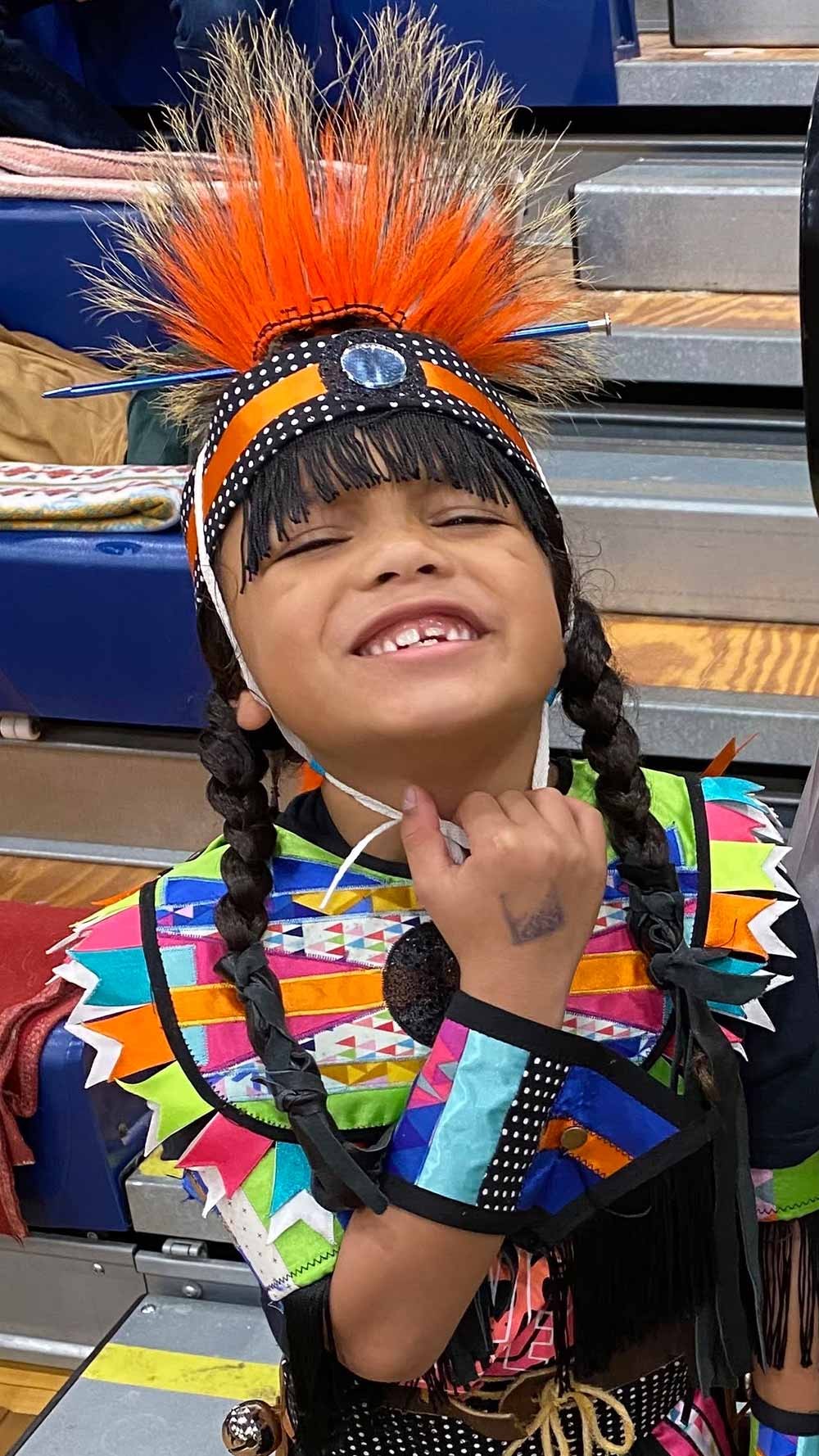The story of Logan Lomboy, a first-grader from the Waccamaw Siouan Tribe, brings to light a crucial question about cultural identity and expression: Why Do Native Americans Wear What They Wear? Logan’s long braid, a symbol deeply rooted in his tribe’s traditions, became a point of contention at his school, highlighting a broader misunderstanding of Native American cultural practices. For many, clothing and hairstyles are simply matters of personal preference or fashion. However, for Native Americans, what they wear often carries profound cultural, spiritual, and historical significance.
Logan, adorned in the traditional clothing of the Waccamaw Siouan Tribe with his hair in braids, showcases the visual representation of cultural heritage.
To understand why Native Americans wear what they wear, it’s essential to delve into the rich tapestry of their cultures and histories. Attire is not merely about covering the body; it’s a powerful form of communication, identity, and spiritual connection.
The Spiritual Significance of Hair
For many Native American tribes, hair is deeply spiritual. As Logan’s mother explained, hair is considered a physical manifestation of the spirit. Cutting hair can be a significant act, often reserved for times of mourning or specific ceremonies. Conversely, allowing hair to grow long can symbolize strength, resilience, and a connection to ancestral traditions.
The Waccamaw Siouan Tribe, like many others, holds long hair in high regard for men. This tradition, stretching back millennia, is not a fleeting trend but a cornerstone of their spiritual and cultural identity. To demand that Logan cut his hair is not just about aesthetics; it’s an infringement upon his spiritual beliefs and cultural heritage.
Traditional Clothing: More Than Just Garments
Beyond hairstyles, traditional Native American clothing is laden with meaning. Historically, and continuing in many communities today, clothing is crafted from materials sourced from the natural environment, reflecting a deep connection to the land. Different materials, colors, and designs can signify tribal affiliation, social status, and ceremonial roles.
For example, certain patterns or motifs woven into textiles might represent tribal stories, clan affiliations, or spiritual symbols. The type of clothing worn can also vary depending on the occasion, from everyday wear to ceremonial regalia used in dances and sacred events like powwows.
Diversity Across Tribes
It’s crucial to recognize that Native America is incredibly diverse. Hundreds of distinct tribes exist across the United States, each with their own unique languages, customs, and traditions – and this diversity is reflected in their attire. What is considered traditional clothing or hairstyles varies significantly from tribe to tribe, depending on geographic location, historical experiences, and cultural practices.
For instance, the elaborate feather headdresses often depicted in popular culture are traditionally associated with Plains tribes like the Lakota or Crow, but are not common or traditional for tribes in the Eastern Woodlands, like the Waccamaw Siouan, or the Southwest. Similarly, clothing materials and styles range from the woven cedar bark clothing of the Pacific Northwest tribes to the deerskin garments of the Eastern tribes and the cotton and wool textiles of the Southwest.
Historical Context: Assimilation and Cultural Suppression
Understanding contemporary Native American attire requires acknowledging the historical context of colonization and forced assimilation. For centuries, Native American cultures and traditions have been under attack, with deliberate attempts to suppress and eradicate them. Indian Boarding Schools, as mentioned in Logan’s story, were a particularly devastating tool of assimilation, where Native children were forcibly removed from their families, forbidden to speak their languages, and made to adopt Euro-American customs, including having their hair cut.
These policies aimed to erase Native American identities and force conformity. Therefore, the act of maintaining and celebrating traditional attire today is not just a matter of personal preference, but often an act of resistance and cultural revitalization. Wearing traditional clothing and hairstyles becomes a powerful statement of cultural pride and a way to reclaim and honor ancestral heritage in the face of historical oppression.
Respecting Cultural Expression
Logan’s experience at school underscores the ongoing challenges faced by Native Americans in expressing their cultural identity in mainstream society. Demanding that he cut his hair is reminiscent of the forced assimilation tactics of the past and demonstrates a lack of understanding and respect for Native American cultural and religious practices.
Logan pictured with his hair in a bun, a compromise he adopted to navigate school policies, which still did not fully acknowledge his cultural needs.
In conclusion, the question “Why do Native Americans wear what they wear?” goes far beyond simple aesthetics. For Native Americans, attire is deeply intertwined with spirituality, cultural identity, historical memory, and tribal affiliation. Understanding the significance of traditional clothing and hairstyles requires acknowledging the diversity of Native American cultures and the historical context of cultural suppression. Respecting Native American cultural expression, including the right to wear traditional attire, is crucial for fostering inclusivity and honoring the rich heritage of Indigenous peoples. Logan’s story serves as a poignant reminder of the importance of education and cultural sensitivity in creating environments where all students can feel proud and secure in their identities.
